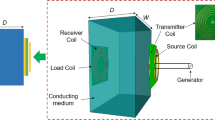Abstract
In recent years, underwater wireless power transmission technology has developed rapidly. Research on omnidirectional wireless power transmission technology in underwater spatial has become increasingly important. Underwater electromechanical devices in the wireless power transmission process and submarine currents’ interference easily cause the radial and axial offset of the transmitting and receiving coils, resulting in changes in the coupling coefficient between the coils, reducing the efficiency and stability of the system energy transmission. The research on the mechanism of underwater spatial omnidirectional wireless power transfer systems has become an urgent problem to be solved in the field of underwater wireless power transmission. To solve this problem, this paper proposes a tri-orthogonal three-dimensional square coil structure that generates an omnidirectional magnetic field in a specific region. An underwater spatial omnidirectional wireless power transfer system is constructed, and theoretical analysis and formula derivation are carried out. Maxwell software is used to simulate the multidimensional electromagnetic field. An experimental verification platform is built, and the experimental results verify the feasibility of the underwater spatial omnidirectional wireless power transfer system, which meets the practical requirements. This design has reference and guiding significance for related industries.




















Similar content being viewed by others
References
Patil D, Mcdonough MK, Miller JM et al (2018) Wireless power transfer for vehicular applications: overview and challenges. IEEE Trans Transp Electrif 4(1):3–37
Siqi LI, Mi CC (2015) Wireless power transfer for electric vehicle applications. IEEE J Emerg Sel Top Power Electron 3(1):4–17
Jin X (2020) Research on the efficiency of multiphase wireless power transfer system with phase-shift control and magnetic field superposition. Int J Electron 108(4):636–646
Orekan T, Peng Z, Shih C (2018) Analysis, design, and maximum power efficiency tracking for undersea wireless power transfer. IEEE J Emerg Sel Top Power Electron 6(2):843–854
Huang J, Zhou Y, Ning Z et al (2019) Wireless power transfer and energy harvesting: current status and future prospects. IEEE Wirel Commun 26(4):163–169
Triviño A, González-González JM, Aguado JA (2021) Wireless power transfer technologies applied to electric vehicles: a review. Energies 14(6):1547
Orekan T, Peng Z, Shih C (2018) Analysis, design and maximum power efficiency tracking for undersea wireless power transfer. IEEE J Emerg Sel Top Power Electron 6(2):843–854
Kehan Z, Yunshan Ma, Zhengchao Y et al (2020) Eddy current loss and detuning effect of seawater on wireless power transfer. IEEE J Emerg Sel Top Power Electron 8(1):909–917
Mohsan SAH, Khan MA, Mazinani A et al (2022) Enabling underwater wireless power transfer towards sixth generation (6g) wireless networks: opportunities, recent advances, and technical challenges. J Mar Sci Eng 10(9):1282
Kim J, Kim K, Kim H et al (2019) An efficient modeling for underwater wireless power transfer using Z-parameters. IEEE Trans Electromagn Compat 61(6):2006–2014
Hasaba R, Okamoto K, Kawata S et al (2019) Magnetic resonance wireless power transfer over 10 m with multiple coils immersed in seawater. IEEE Trans Microwav Theor 67(11):4505–4513
Azad A, Tavakoli R, Pratik U et al (2020) A smart autonomous WPT system for electric wheelchair applications with free-positioning charging feature. IEEE J Emerg Sel Top Power Electron 8(4):3516–3532
Zhengchao Y, Yiming Z, Kehan Z et al (2019) Underwater wireless power transfer system with a curly coil structure for AUVs. IET Power Electron 12(10):2559–2565
Wei-dong N, Ling Ma, Bo Z et al (2017) A brief analysis of united states unmanned underwater combat system. J Unmanned Undersea Syst 25(4):310–318
Canjun Y, Mingwei L, Dejun Li (2020) Improving steady and starting characteristics of wireless charging for an AUV docking system. IEEE J Ocean Eng 45(2):430–441
Zhang B, Xu W, Lu C et al (2022) Review of low-loss wireless power transfer methods for autonomous underwater vehicles. IET Power Electron 15(9):775–788
Pham TS, Nguyen TD, Tung BS et al (2021) Optimal frequency for magnetic resonant wireless power transfer in conducting medium. Sci Rep 11(1):1–11
Kojiya T, Sato F, Matsuki H et al (2004) Automatic power supply system to underwater vehicles utilizing non-contacting technology. Oceans’ 04 MTS/IEEE techno-ocean’04. IEEE, New York, pp 2341–2345
Liu D, Hu H, Georgakopoulos SV (2017) Misalignment sensitivity of strongly coupled wireless power transfer systems. IEEE Trans Power Electron 32(7):5509–5519
Yan Z, Zhang K, Wen H et al (2016) Research on characteristics of contactless power transmission device for autonomous underwater vehicle. OCEANS 2016-Shanghai. IEEE, New York, pp 1–5
Kuang XJ (2006) Magnetic field of square current-carrying coil. Phys Eng 16(1):18–25
Author information
Authors and Affiliations
Contributions
Author Statement Manuscript title: Design and Implementation of an Underwater Spatial Omnidirectional Wireless Power Transfer System We have made substantial contributions to the conception or design of the work. We have drafted the work or revised it critically for important intellectual content, and I have approved the final version to be published. I agree to be accountable for all aspects of the work in ensuring that questions related to the accuracy or integrity of any part of the work are appropriately investigated and resolved. All persons who have made substantial contributions to the work reported in the manuscript, including those who provided editing and writing assistance but who are not authors, are named in the Acknowledgments section of the manuscript and have given their written permission to be named. If the manuscript does not include Acknowledgments, it is because the authors have not received substantial contributions from nonauthors. Author: Xiche Zhang, Jin Xu
Corresponding author
Ethics declarations
Competing interests
The authors declare no competing interests.
Additional information
Publisher's Note
Springer Nature remains neutral with regard to jurisdictional claims in published maps and institutional affiliations.
Rights and permissions
Springer Nature or its licensor (e.g. a society or other partner) holds exclusive rights to this article under a publishing agreement with the author(s) or other rightsholder(s); author self-archiving of the accepted manuscript version of this article is solely governed by the terms of such publishing agreement and applicable law.
About this article
Cite this article
Zhang, X., Xu, J. Design and Implementation of an Underwater Spatial Omnidirectional Wireless Power Transfer System. Electr Eng 105, 3347–3362 (2023). https://doi.org/10.1007/s00202-023-01877-5
Received:
Accepted:
Published:
Issue Date:
DOI: https://doi.org/10.1007/s00202-023-01877-5




